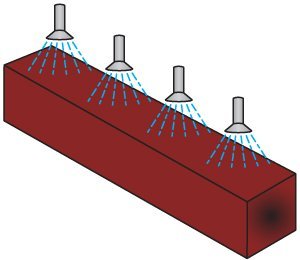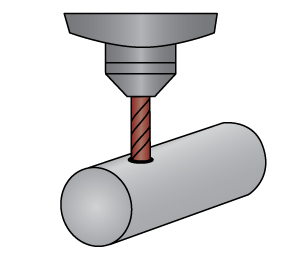- Previous blog
- Next blog
- Huyett Marketing Department
- 05/10/2021
Characterized by their durability, hardness, price, and ability to withstand shock without deforming, tool steels are used to cut, press, extrude, or stamp other metals. After being worked, they may be hardened to increase wear resistance and strength. Grades are specified by the American Iron and Steel Institutde (AISI), the Society of Automotive Engineers (SAE), or the American Society for Testing and Materials (ASTM).
Design Considerations
Heat Treating

After machining, steel is heat treated and quenched, depending on the type of steel used, to increase toughness and strength.
Durability

Resistance to deformation at elevated temperatures (also known as red‑hardness)
Comparative Cost

Low cost water‑hardening tool steel is used more often than oil- or air‑hardening tool steels
Tool Steel Grades
Tool steels are defined by their dimensional stability, wear resistance, toughness, hot hardness, and machinability. Severe conditions – high temperatures, heavy loads, or corrosive environments – require higher alloy and carbon contents.
How Standards Help Manufacturers
In the manufacturing industry, standards establish a common set of requirements to ensure conformity of products across all vendors. This eliminates trade borders, creates uniformity in production. Standards can also increase operational efficiency due to a strong focus on process that contributes to a reduction in production costs.
Cold Work Steels
Frequently used for making cold working tools for applications under 200°C (392°F). Higher amounts of chromium reduce distortion during heat treatment. Feature high hardenability, high toughness, and high abrasion, impact, and wear resistances.
A2-A10, Air-Hardening
Medium alloy composition with 1% – 6% carbon and up to 5% chromium. Has the least tendency to crack during hardening. Considered a mid‑range grade between oil‑hardening and shock resistant grades. Do not quench in oil or water.
01‑07, Oil‑Hardening
A low alloy/high carbon (0.85% – 1.55%) steel with manganese, chromium, and molybdenum. Quenched in oil to produce high wear resistance and hardness between HRC 56‑62.
D2‑D7, High Carbon, High Chromium
Contain 1.4% – 2.3% carbon and 12% – 14% chromium along with molybdenum, cobalt, and vanadium. Often thought of as stainless or semi‑stainless, but corrosion resistance is limited due to high chromium and carbon. Wear resistant, but not as tough as low alloy steels.
Hot Work Steels
Feature high hot yield strength, toughness, high red‑hardness, wear resistance, erosion resistance, and resistance to softening in temperatures up to 675°C (1,247°F).
H1‑H19
Medium carbon content with 5% chromium. Can be through hardened to HRC 40‑55 with little distortion. Requires oil quenching.
H20‑H26
Low carbon content with 9% – 18% tungsten and 3% – 4% chromium. Extra resistant to softening, more prone to brittleness, working hardness to HRC 45‑55. To minimize scaling, quench in oil or salt.
H41‑H43
Low carbon content with 8% molybdenum along with chromium, tungsten, and vanadium.
Water-Hardening Steels
W1‑W3
Most common. These general purpose, low‑cost, medium to high carbon (0.60% – 1.3%) steels are easily machined, or formed. They can be case hardened by heat treating up to HRC 68. Overall, they are more brittle and more susceptible to cracking or warping than other steels. Best suited for small parts and working conditions up to 150°C (302°F).
High-Speed Steels (HSS)
Designed for high speed metal cutting and machining operations. Features hardenability to HRC 60‑70, high heat resistance for red‑hardness up to 500°C (932°F) enables sharpening without damaging material, and reasonable toughness.
M1‑M47
Contain molybdenum as a primary alloying element that increases resistance to softening at elevated temperatures.
Shock-Resistant Steels
S1‑S7
Contain medium carbon content from 0.40% – 0.55%, 1% – 2% silicon, or up to 3% nickel. As their name suggests, they have good wear/abrasion resistance and resist shock at low to medium temperatures, with high strength and toughness. Can achieve HRC 58‑60.
Tool Steel Types
Ground Stock
Ground stock is rectangular or square steel that has been ground to close tolerances for use in a wide range of industries. Once shaped, ground stock may be heat treated to harden.

Drill Rod
Drill rod is round unhardened tool steel which is precision ground to tight tolerances. After machining, it may be hardened by heat treating, then drawn back to the desired hardness.

Definitions
Hardness
The measure of how resistant steel is to various kinds of permanent deformation when a force is applied.
Strength
A measure of steel’s elastic range, where it will return to its original shape when gradual force is removed.
Toughness
The maximum amount of energy or impact force that can be absorbed before fracturing.
Quick Reference Guide
Ground Stock
Common Names:
Tool Steel, Ground Flat Stock, Flat Bar Stock, Flat Stock, Gauge Plate
Tool Steel, Ground Flat Stock, Flat Bar Stock, Flat Stock, Gauge Plate
Applicable Standards:
AISI/SAE A2, AISI/SAE D2, AISI/SAE O2, AISI/SAE W2
AISI/SAE A2, AISI/SAE D2, AISI/SAE O2, AISI/SAE W2
Fabrication:
Cold drawn, annealed bar stock that is subsequently ground to remove all traces of decarburization and achieve precision height and width.
Cold drawn, annealed bar stock that is subsequently ground to remove all traces of decarburization and achieve precision height and width.
How to Identify:
Tight tolerances and ground surface finish. Durable and resistant to abrasion.
Tight tolerances and ground surface finish. Durable and resistant to abrasion.
Common Uses:
Depending on grade, ground stock can be used as dies, punches, templates, and stripper plates.
Depending on grade, ground stock can be used as dies, punches, templates, and stripper plates.
Comments:
Ground stock is free from decarburization.
Ground stock is free from decarburization.
Drill Rod
Common Names:
Drill Rod
Drill Rod
Applicable Standards:
AISI/SAE A2, AISI/SAE D2, AISI/SAE O2, AISI/SAE H13, AISI/SAE W2
AISI/SAE A2, AISI/SAE D2, AISI/SAE O2, AISI/SAE H13, AISI/SAE W2
Fabrication:
Cold drawn, annealed round stock that is ground and polished to achieve exacting size with no decarburization left on the bars.
Cold drawn, annealed round stock that is ground and polished to achieve exacting size with no decarburization left on the bars.
How to Identify:
Tight tolerances and ground surface finish. Durable and resistant to abrasion.
Tight tolerances and ground surface finish. Durable and resistant to abrasion.
Common Uses:
Drill rod, depending on grade, is used to make tools like drill bits, taps, dowel pins, and hammers.
Drill rod, depending on grade, is used to make tools like drill bits, taps, dowel pins, and hammers.
Comments:
Drill rod is free from decarburization.
Drill rod is free from decarburization.
Mild Steel vs. Hardened Steel
Hardened steel is much more difficult to work or machine. Mild steel can generally be machined using high‑speed steel (HSS) or cobalt tools. Both mild steel and hardened steel can be called “ground” as this refers to a method used to shape steel, not the material or the tempering process.
Have a piece of steel and are unsure if it has been hardened or not? Here’s an easy way to find out:

Left: Mild steel can be filed fairly easily and leaves a visible relief. Right: A file will tend to skid along the surface of hardened steel.
Learn More About Flat Stock and Drill Rod